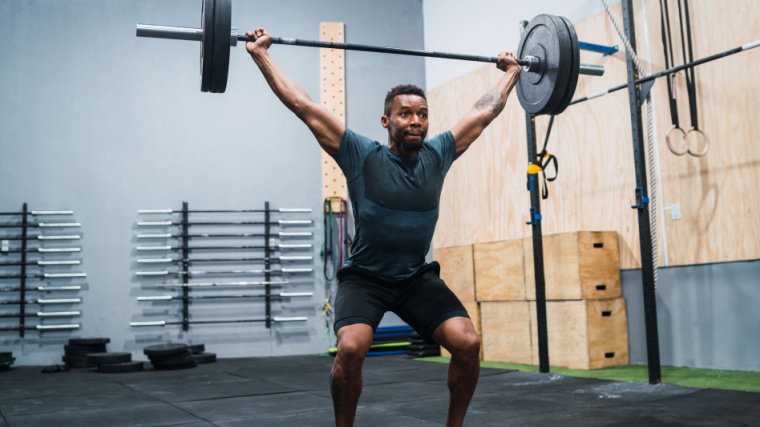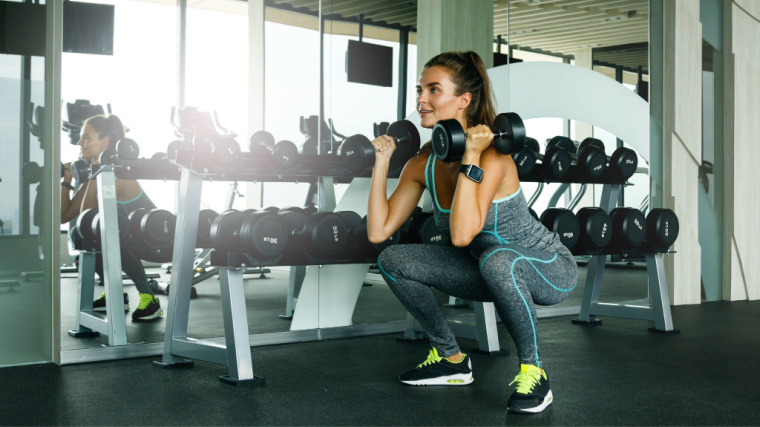
Complexes, also known as combination lifts, consist of two or more exercises performed with the same free weight in a non-stop, continuous fashion. While this method may initially appear similar to low-intensity circuit training commonplace in machine-laden rec centers, true complexes are quite the opposite.
Romanian weightlifting coach Istvan Javorek popularized complexes in the 1970s to enhance athletes’ training intensity, increase workout efficiency, and eliminate the monotony of traditional “exercise, rest, exercise, rest” barbell training. (1)

Complexes are unique because they simultaneously train the muscular, cardiovascular, and neurological systems. They challenge your muscles, heart, lungs, and coordination. Learn classic barbell complexes along with creative complexes using dumbbells, kettlebells, and sandbags, then put them to work to ignite new gains.
Simplifying Workout Complexes
How Workout Complexes Work
A complex strings together multiple exercises without rest. Unlike circuit training and some types of supersets, complexes must be performed with the same piece of equipment because the transition from one exercise to the next must occur smoothly and without pause.
Complexes commonly involve the Olympic weightlifting movements (i.e. clean & jerk, snatch) and their derivatives such as pulls and front squats. (2) Many coaches falsely believe complexes “must” consist of a power clean to get the barbell off the ground, followed by one or two additional exercises, such as a press and then an overhead squat. (3)
In reality, complexes can be performed using a wide variety of exercises and implements.
According to Javorek, the number of possible complexes is “unlimited, depending on a coach’s knowledge and creativity, the availability of equipment, and the goals of the coach and athletes.” (3)
Classic Barbell Complexes
Performing complexes with a series of exercises using a single barbell may be the most common way to implement this training method. Here are two complexes that are relatively well-known in the weightlifting world.
Javorek Complex 1
Coach Javorek’s “Complex 1” incorporates Olympic weightlifting assistance exercises that build full-body power, coordination, and conditioning. Complex 1 includes the upright row, high pull snatch, squat push press, good morning, bent-over row, and high pull snatch (again). (1)(3) Javorek advocated ending the complex with a dynamic movement, hence the repeat performance of the high pull snatch. (3)
One cycle of Complex 1 consists of 6 repetitions per exercise. Note that Coach Javorek also promoted “Complex 2,” which consists of the same exercises performed for three repetitions each. (1)(3)
Upright Row
- How to Do it: Stand with your feet hip-width apart. Hold the barbell at mid-thigh position with an overhand grip. Push with your legs toward the ceiling, rising onto the balls of your feet. Carry that momentum into a shrug and vertical row, drawing your elbows up and out. Control the negative.
- Sets and Reps: 4-5 x 6
- Rest time: No rest before moving to the next exercise.
High Pull Snatch
- How to Do it: Using the same stance and grip as the previous exercise, begin with the barbell on the floor above the front of your feet. Keeping your back tight, pull the bar from the floor by extending knees, ankles, and hips. As the bar passes mid-thigh, aggressively shrug your shoulders. Allow your arms to carry the momentum to the overhead position while keeping the bar close to the body. Receive the bar overhead with elbows straight. Reverse the motion and control the negative in the same bar path. On the last rep of the set, carefully “land” the bar across your upper traps instead of the floor, so you’re in position to begin the next movement.
- Sets and Reps: 4-5 x 6
- Rest time: No rest before moving to the next exercise.
Squat Push Press
- How to Do it: Using a shoulder-width stance, begin with the barbell racked on your upper traps. Drop into a full back squat. Immediately drive back to standing, using the momentum to assist with an overhead press. Control the negative back to the racked position on your traps. Repeat the entire “squat and press” combination for each repetition.
- Sets and Reps: 4-5 x 6
- Rest time: No rest before moving to the next exercise.
Good Morning
- How to Do it: Keep the same stance and hold the barbell behind your head on your upper traps. Allow your weight to shift to your heels as you bend forward by hinging or flexing at the hips. Maintain an arched spine and slightly bent legs throughout. Reverse the movement, driving your hips forward, and return to standing. On the last rep of the set, “squat and press” to pop the bar barely over your head and bring the bar to waist-height under control.
- Sets and Reps: 4-5 x 6
- Rest time: No rest before moving to the next exercise.
Bent-Over Row
- How to Do it: Begin in a shoulder-width stance with the barbell held in front of your body in an overhand grip. Hinge forward and allow the barbell to hang below your chest. Depending on your flexibility and limb length, the bar may or may not touch the floor. Row by pulling your elbows up and out as you squeeze your shoulder blades together. Control the bar as you allow it to return to the stretched position.
- Sets and Reps: 4-5 x 6
- Rest time: No rest before moving to the next exercise.
High Pull Snatch
- How to Do it: Using the same stance and grip as the previous exercise, begin with the barbell on the floor above the front of your feet. Keeping your back tight, pull the bar from the floor by extending knees, ankles, and hips. As the bar passes mid-thigh, aggressively shrug your shoulders. Allow your arms to carry the momentum to the overhead position while keeping the bar close to the body. Receive the bar overhead with elbows straight. Reverse the motion and control the negative in the same bar path.
- Sets and Reps: 4-5 x 6
- Rest time: Rest one to three minutes before repeating the first exercise.
Bear Complex
Popularized by CrossFit in the 2000s, the Bear complex builds full-body strength, power, and conditioning with one barbell and just few bumper plates.
“The Bear” consists of the power clean, front squat, overhead press, back squat, and another dose of the overhead press.
Power Clean
- How to Do it: Stand with your feet hip-width apart. Hold the barbell at knee-height (the “hang position”) with a shoulder-width overhand grip. Push with your legs as you guide the bar toward your hips. Once the bar reaches mid-thigh, rapidly shrug and pull the bar up. Drop under the bar and shoot your elbows forward to receive the bar on the fronts of your shoulders in the “front rack” position.
- Sets and Reps: 5 x 5-7
- Rest time: No rest before moving to the next exercise.
Front Squat
- How to Do it: Maintain the front rack position with the bar resting across the fronts of your shoulders. Adjust your grip to comfortably maintain control of the bar. Squat down while keeping your torso upright and your elbows aimed forward. After descending as far as your mobility will allow, stand up forcefully.
- Sets and Reps: 5 x 5-7
- Rest time: No rest before moving to the next exercise.
Overhead Press
- How to Do it: Standing with the bar in the front rack position, perform a slight countermovement or mini-squat and immediately drive upward to push the bar toward the ceiling. Lock your arms overhead before lowering the weight to shoulder-level. Repeat the mini-squat prior to each press. On the last rep of each set, carefully guide the bar to rest across your traps and the backs of your shoulders.
- Sets and Reps: 5 x 5-7
- Rest time: No rest before moving to the next exercise.
Back Squat
- How to Do it: Secure the barbell across your upper back. Ensure your feet are approximately shoulder-width apart. Squat down as far as your mobility allows. Return to standing. On the last rep of each set, drive the weight overhead with a press and carefully lower it to the front of your shoulders.
- Sets and Reps: 5 x 5-7
- Rest time: No rest before moving to the next exercise.
Overhead Press
- How to Do it: Standing with the bar in the front rack position, perform a slight countermovement or mini-squat and immediately drive upward to push the bar toward the ceiling. Lock your arms overhead before lowering the weight to shoulder-level. Repeat the mini-squat prior to each press.
- Sets and Reps: 5 x 5-7
- Rest time: Rest up to five minutes before repeating the first exercise.
Complexes with Kettlebells, Dumbbells, and Sandbags
Who says complexes need be limited to barbells? People who don’t understand complexes. That’s who. Dumbbells, kettlebells, and even sandbags are great tools for complexes.
These alternative implements build brute strength, total-body coordination, and unrelenting conditioning. Give these complexes a try when you need a break from traditional barbell training or when you’re working with limited equipment.
Javorek Dumbbell Complex 1
Coach Javorek programmed dumbbell complexes using two dumbbells, although a single dumbbell is a viable option provided you repeat the complex on the other side after performing all exercises on the first side. (3)
Complex 1 with dumbbells is similar to Javorek’s barbell Complex 1. Aside from the obvious use of dumbbells instead of a barbell, the dumbbell version eliminates the good morning. It consists of the dumbbell upright row, dumbbell snatch, dumbbell squat push press, bent-over dumbbell row, and a repeat of the dumbbell snatch.
Dumbbell Upright Row
- How to Do it: Begin bent slightly forward at the hips with the dumbbells hanging at knee-height. Forcefully extend your hips, knees, and ankles and transfer the momentum into a vertical pull of the dumbbells. In the top position, your elbows should be near shoulder-height and the weights should be near chest-level. Control the negative (lowering phase) to the starting position.
- Sets and Reps: 3-6 x 6
- Rest time: No rest before moving to the next exercise.
Dumbbell Snatch
- How to Do it: Start in a hip-width stance with the dumbbells hanging in front of your knees with your palms facing your body. Powerfully drive through your legs and carry the momentum through the dumbbells. Draw the dumbbells along the front of your body and receive them overhead with your arms straight. Control the negative and return the weights to knee-height. On the last rep of the set, lower the weights only to shoulder-level.
- Sets and Reps: 3-6 x 6
- Rest time: No rest before moving to the next exercise.
Dumbbell Squat Push Press
- How to Do it: Start in a shoulder-width stance with the dumbbells on the tops of your shoulders. Drop into a full squat, then immediately drive back to standing. Use the momentum to propel the dumbbells into the overhead lockout position. Lower the weight to shoulder-level and repeat. One the last rep of the set, bring the dumbbells to waist-height with straight arms.
- Sets and Reps: 3-6 x 6
- Rest time: No rest before moving to the next exercise.
Dumbbell Bent-Over Row
- How to Do it: Bend forward at your hips with a slight bend in your knees. Allow the dumbbells to hang from your straight arms, slightly in front of your knees. Row the dumbbells up and out by pulling the elbows out in line with your shoulders. Return to the stretched position under control. After the last rep of the set, stand upright with the weights in front of you.
- Sets and Reps: 3-6 x 6
- Rest time: No rest before moving to the next exercise.
Dumbbell Snatch
- How to Do it: Start in a hip-width stance with the dumbbells hanging in front of your knees with your palms facing your body. Powerfully drive through your legs and carry the momentum through the dumbbells. Draw the dumbbells along the front of your body and receive them overhead with your arms straight. Control the negative and return the weights to knee-height.
- Sets and Reps: 3-6 x 6
- Rest time: Rest one to three minutes before repeating the first exercise.
Kettlebell Complex
This kettlebell complex is performed with two kettlebells and uses a descending repetition scheme. Repetitions are reduced with each successive exercise, allowing you to maintain intensity as fatigue accumulates.
The exercises in this complex are the double kettlebell swing, kettlebell front squat, and kettlebell push press. If you’re only using a single kettlebell, perform the same series while holding the kettlebell with both hands for each exercise.
Double Kettlebell Swing
- How to Do it: Start in a wide stance (one-and-a-half times your shoulder-width) holding the kettlebells in front of your body. Brace your midsection muscles and “hike” both kettlebells back between your legs as you “break” or flex at the hips. Your forearms should contact your inner thighs. Explosively extend your hips, projecting your arms and the kettlebells forward. Allow the momentum from your hip drive to carry the kettlebells. Allow the downward motion of the kettlebells to dictate the timing of the next repetition — at the last moment, break at the hips again and repeat the swing. On the last repetition, bring the weights to shoulder-level using a “cheat curl” or power clean-motion.
- Sets and Reps: 12 x 8
- Rest time: No rest before moving to the next exercise.
Kettlebell Front Squat
- How to Do it: Bring your stance in to shoulder-width, with the kettlebells “racked” atop your upper chest region and your palms facing down. Keep your elbows pointed up and out as you drop into a squat with an upright torso. Return to standing.
- Sets and Reps: 12 x 6
- Rest time: No rest before moving to the next exercise.
Kettlebell Push Press
- How to Do it: Maintain a shoulder-width stance and keep the kettlebells “racked” near your upper chest. Perform a rapid quarter-squat and quickly drive back to standing. Use the momentum from your leg drive to push the kettlebells overhead. Lower the weights to shoulder-level under control and repeat.
- Sets and Reps: 12 x 4
- Rest time: Rest approximately the same amount of time the entire three-exercise cycle took to complete, for a 1:1 work-to-rest ratio.
Sandbag Complex
Sandbags are an unstable and downright awkward training implement — and that’s what makes them fun for complexes. Whether you shell out money for a professionally made, loadable sandbag or use a homemade version with a duffel bag and some play sand from the hardware store, sandbag workouts always end up more challenging than you expect.
This sandbag complex includes the sandbag clean, sandbag front squat, and sandbag reverse lunge.
Sandbag Clean
- How to Do it: Start with your feet at hip-width with the sandbag on the ground in front of you. Grab the sandbag at the corners or, if available, hold the handles on the long side of the bag. Extend your hips, knees, and ankles to accelerate the bag upwards while keeping the sandbag close to your body. Drop under the bag, shoot your elbows forward, and “catch” the sandbag in the front rack position across the front of your shoulders. Stand fully upright before returning the bag to the ground. On the last rep of the set, hold the bag in position and don’t place it on the ground.
- Sets and Reps: 4-6 x 3
- Rest time: No rest before moving to the next exercise.
Sandbag Front Squat
- How to Do it: Stand upright with the sandbag racked across the fronts of your shoulders. Drop into a squat while keeping your elbows high and your back straight. Drive back to standing. Repeat for repetitions.
- Sets and Reps: 4-6 x 5
- Rest time: No rest before moving to the next exercise.
Sandbag Reverse Lunge
- How to Do it: Stand upright with the sandbag in the front rack position across your shoulders. Take a large step backwards with one leg and lower your back knee toward the ground. Return to the starting position with your feet together and repeat using the other leg. Alternate legs with each repetition.
- Sets and Reps: 4-6 x 5 per leg
- Rest time: Rest one to three minutes before repeating the first exercise.
Benefits of Using Complexes
Now that you’ve seen a couple of classic complexes, consider the training effects of this style training. Complexes provide varied, high volume, metabolically demanding training. Because you never put down the weight, some muscles tend to be trained throughout the entire complex.
These typically include the forearm (“grip”) muscles and postural muscles of your spine. Complexes thereby enable lifters to improve local muscle endurance in areas that commonly limit performance.
Modern complexes stem from Olympic weightlifting, a sport of quick lifts — the clean & jerk and the snatch. Therefore, each repetition in the complex should be performed with maximum intent for velocity. This promotes high power outputs and speed-strength training adaptations.

Complexes are essentially high-volume sets divided into shorter sets, or clusters, of each exercise. These clusters are linked together without pause. Breaking longer sets into shorter clusters is known to promote power and performance. (4)
While you are certainly not “resting” between clusters of each exercise during a complex, many muscles get relative rest. For example, during Complex 1, your shoulders get a break during the good morning and your legs get a bit of break during the bent-over rows. This feature allows power output to be preserved throughout high-volume workouts.
Although complexes are great for training muscular strength and power, don’t fail to appreciate their cardiovascular training demands. By minimizing rest, complexes pack plenty of productive training in short periods of time. Complexes ultimately train multiple energy systems. The quick-energy phosphagen and anaerobic glycolysis systems are trained during initial repetitions of ballistic exercises, and the all-important aerobic system is trained in the latter repetitions and throughout recovery between complexes.
Complexes are also useful for reenforcing exercise technique. Exercise derivatives, often representing key components of a more complex lift such as the clean & jerk or snatch, can be linked together in a complex to enhance learning. (5) In addition to the technical demands of each exercise, the athlete is tasked with seamlessly transitioning from one exercise to the next. These fluid transitions build new coordination and enhance motor control.
Toward the end of the complex, the athlete must continue to demonstrate crisp technique despite growing fatigue. This is a common demand of many sports. As such, complexes are thought to promote sport performance and injury prevention. (2)(6)(7)(8)
Who Should Perform Workout Complexes?
While complexes were originally used for competitive strength sport athletes, they’re not only for advanced lifters. When properly programmed with the right exercises and training volume, many lifters can incorporate complexes into their training program.
Complexes as Warm-Ups
No matter what your workout holds, a complex can serve as an invigorating and effective warm-up. Use a light weight (or even an empty barbell). Perform two sets of a complex near the beginning of your session. (3) Any complex can raise your body temperature, but the best warm-ups are specific to the ensuing workout. (2)

Attempt to use complexes with movement patterns similar to the demands, goals, and exercises of the session’s workout. A complex comprised of lower body movements before a big leg workout, for example, or dumbbell Complex 1 before a back or shoulder workout.
Complexes for Weightlifting Prep and Motor Learning
If a complex includes movements complimentary to the primary lift of the workout, the complex can serve as specific movement prep. (2) By combining exercise variations and assistance exercises in a complex, you reinforce positions and movement patterns required for your primary lift of the day.
For example, a complex consisting of a Romanian deadlift (RDL), jump shrug, and hang clean is excellent movement prep for the higher complexity clean exercise. The complex re-enforces key technical aspects of the clean in simpler forms via a learning strategy called “chunking.” (9)
The complex serves to activate and mobilize muscles like the hamstrings and potentiate the triple extension movement pattern used in the clean. Altogether, these features are expected to enhance subsequent exercise performance.
Complexes for Sports Performance, Post-Rehabilitation Training, and Injury Prevention
Because complexes may be progressively intensified by manipulating the weight, volume, rest intervals, and complexity of the exercises, they are wonderful tools for training for the physiological demands of sport.
Complexes are commonly used to recondition previously injured athletes for the demands of sports. (7)(8) Although it is best to work with your sports medicine provider for individualized recommendations, post-rehabilitation complexes typically involve progressive intensities and volumes. A common post-rehabilitation recommendation is to begin with a weight of 10-15% of your body weight for Javorek Complex 1 and progress to 35% of body weight over the course of a month. (7)(8)
Developing strength, power, and coordination via complexes may minimize the risk of athletic injury, but consistent and progressive programming is absolutely essential. Complexes are typically performed three times per week and progressed by gradually adding weight or gradually adding cycles to the complex. (3)(7)(8)
Complexes for Conditioning
Due to their high volume nature, complexes are an effective form of metabolic conditioning. Choose a complex using barbells, kettlebells, dumbbells, or even a landmine unit for an effective general physical preparedness (GPP) and cardiovascular training stimulus.
Here’s an example of conditioning complex requiring only a single dumbbell. Perform four repetitions per movement:
- Dumbbell Snatches
- Dumbbell Reverse Lunge
- Dumbbell Push Press
- Overhead Squat
Repeat immediately with the dumbbell in the other hand and that’s one cycle of the complex. Rest 90 seconds after the second side. Perform three to five cycles with each arm.
Programming Recommendations for Workout Complexes
While complexes can deliver a variety of benefits, some programming goals will ensure an efficient training session with maximal intensity and recovery.
Anchor Intensity on the Most Challenging Movement
When stringing together a chain of exercises, you’re only as strong as your weakest movement. Therefore, the weakest movement must dictate the weight used for any complex.
For example, Coach Javorek programs the weight used for Complexes 1 and 2 on the upright row, because it is more challenging than the other movements (high pull snatch, push press, good morning, or bent-over row). (6) Start by identifying the weakest link in the complex, then program your working weight according to your goal.
Program According to Your Primary Training Goal
From movement prep to performance training, complexes can be effective for a wide variety of goals. The parameters of your programing (exercise selection, intensity, volume, and rest intervals) should reflect the primary purpose of your complex.
For power and strength training, most of your complexes should be performed with moderate weights. Perform all repetitions with maximum intent for movement velocity. (10) Repetitions for each exercise within the complex should be kept relatively low. Clusters of two to five repetitions are effective for building strength and power. (4)

Ensure your reps stay quick and crisp throughout the complex, as greater velocity loss may result in diminished power adaptations. (11) If your final reps of each exercise are losing speed, reduce the weight and/or repetitions.
For conditioning, consider the rest intervals between complexes. To prioritize aerobic training adaptations, use shorter rest intervals (e.g. one minute). Recognize that short rest intervals will also necessitate lighter weights and/or lower repetition volumes. To prioritize adaptations in the phosphagen and glycolytic energy systems, allow longer rest between complexes (e.g. 90 seconds to five minutes).
For coordination and motor learning, light loads are initially recommended. Moderate-to-high repetition volume (e.g. eight to 12 repetitions per exercise) may be most effective, provided the technique does not break down due to fatigue. (9)
Complexes, Simplified
Complexes are one of the most invigorating training methods. They’re also incredibly versatile, facilitating the development of strength, power, coordination, conditioning, and resiliency. Although traditional complexes are performed exclusively with barbells, you should feel empowered to use equipment of your choice, including, but not limited to dumbbells, kettlebells, landmines, medicine balls, and sandbags.
References
- Javorek, I. (1988). Exercise techniques: General conditioning with complex I and II. Strength & Conditioning Journal, 10(1), 34-37.
- Judge, L. W. (2008). Core Training for Superior Sports Preparation. Journal of Coaching Education, 1(2), 38-63.
- Javorek, I. S. (1998). The benefits of combination lifts. Strength & Conditioning Journal, 20(3), 53-57.
- Moreno, S. D. et al. (2014). Effect of cluster sets on plyometric jump power. The Journal of Strength & Conditioning Research, 28(9), 2424-2428.
- Duba, J., Kraemer W.J., & Gerard Martin, M. A. (2007). A 6-step progression model for teaching the hang power clean. Strength and Conditioning Journal, 29(5), 26.
- Javorek, I. (1990). All-sports conditioning: Six-week training program. Strength & Conditioning Journal, 12(4), 62-69.
- Panariello, R. A., Stump, T. J., & Cordasco, F. A. (2017). The lower extremity athlete: postrehabilitation performance and injury prevention training. Operative Techniques in Sports Medicine, 25(3), 231-240.
- Lorenz, D., & Maddalone, D. (2017). Postrehabilitation performance enhancement training and injury prevention in the upper extremity. Operative Techniques in Sports Medicine, 25(3), 220-230.
- Morris, S. J., et al. (2020). Taking a long-term approach to the development of weightlifting ability in young athletes. Strength & Conditioning Journal, 42(6), 71-90.
- Behm, D. G., & Sale, D. G. (1993). Intended rather than actual movement velocity determines velocity-specific training response. Journal of Applied Physiology, 74(1), 359-368.
- Pareja‐Blanco, F., et al. (2017). Effects of velocity loss during resistance training on athletic performance, strength gains and muscle adaptations. Scandinavian Journal of Medicine & Science in Sports, 27(7), 724-735.
Featured Image: Ground Picture / Shutterstock






